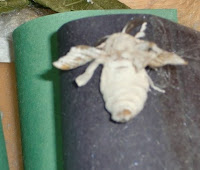This spring my preschooler's teacher got some hatched silkworms from the RAFT organization so she could have her students observe their lifecycle. She initially put them them in a shoe box
(as they were tiny) with plenty of mulberry leaves. The mulberry leaves is their preferred food, however they can also eat spinach or lettuce leaves. These worms were tiny light green and rusty.
The pictures below are of the silkworm, two weeks after they were brought:


However due to their enormous appetite they kept feeding on the mulberry leaves and grew. She moved them to a big plastic container with lid. All of them grew at different rates, however not a single worm crawled out of the shoe box or the plastic container!

As the silkworms grew the teacher started keeping rolls made out of thick paper sheet in the plastic container. 4 - 5 weeks after they were brought to school the first one crawled in to the roll and started making a coccoon. It made the coccoon within a day!


In the following 1-2 weeks most of the silkworms had gone in to their coccoons. Some of the coccoons were yellow. It is normal since those were wild silkworms and can have their coccoons in non-white color. As people prefer white color (as it could be dyed in to any color) they started breeding silkworms that would give only white silk.

.jpg)
For commercial use the coccoons are put in to boiling water and treated while the moth is still inside the coccoon. The enzymes secreted by the moths to break the coccoon damages the silk and hence they are not given any chance to come out.
After about 4-5 weeks of being in the coccoon, the silkworm moths finally came out. At this stage they do not need any food, nor do they fly. They go through the reproductory phase, lay eggs and die. These eggs can be stored in the refrigerator and used in the next spring to hatch more silkworms.

.jpg)
.jpg)
The silk from the cocoons is very strong and is stretched in to a hankerchief after treating the coccoons. It is then spun in to thread.


The entire lifecycle of the silkworm
(egg -> catterpillar -> coccoon -> moth) spanned over 2.5 months and almost everyday me and my kids watched it with great excitement.
Did you actually make your own silk thread? I have never quite had the heart to try, as you should kill the contents of the cocoon to get a complete/intact thread. I wonder if one could just make silk felt after the moth has hatched.
ReplyDeleteHello Tarry,
ReplyDeleteNo we did not make our silk thread. The purpose of the experiment was to learn the lifecycle of silkworm.
The boiling of cocoons while the pupa is still inside is done for commercial process, reason being that the enzymes the moths secrete to break out of the cocoon destroys the silk fiber and threads do not come out long.
However for experimenting @ home, it should be okay to boil the cocoon after the moth has come out. This will separate out the threads but they will be of shorter and varying lengths.
Hope this helps.
Dear shalaka,
ReplyDeleteFrom your daughter:
I just love how much detail you put in this. Can I have a clothe made from silk?
This comment has been removed by a blog administrator.
ReplyDeleteThis comment has been removed by a blog administrator.
ReplyDeleteThis comment has been removed by a blog administrator.
ReplyDeletealthough it was good i thought there could be more improvement like when the silworm does all this known as sericulture but overall it was good
ReplyDelete